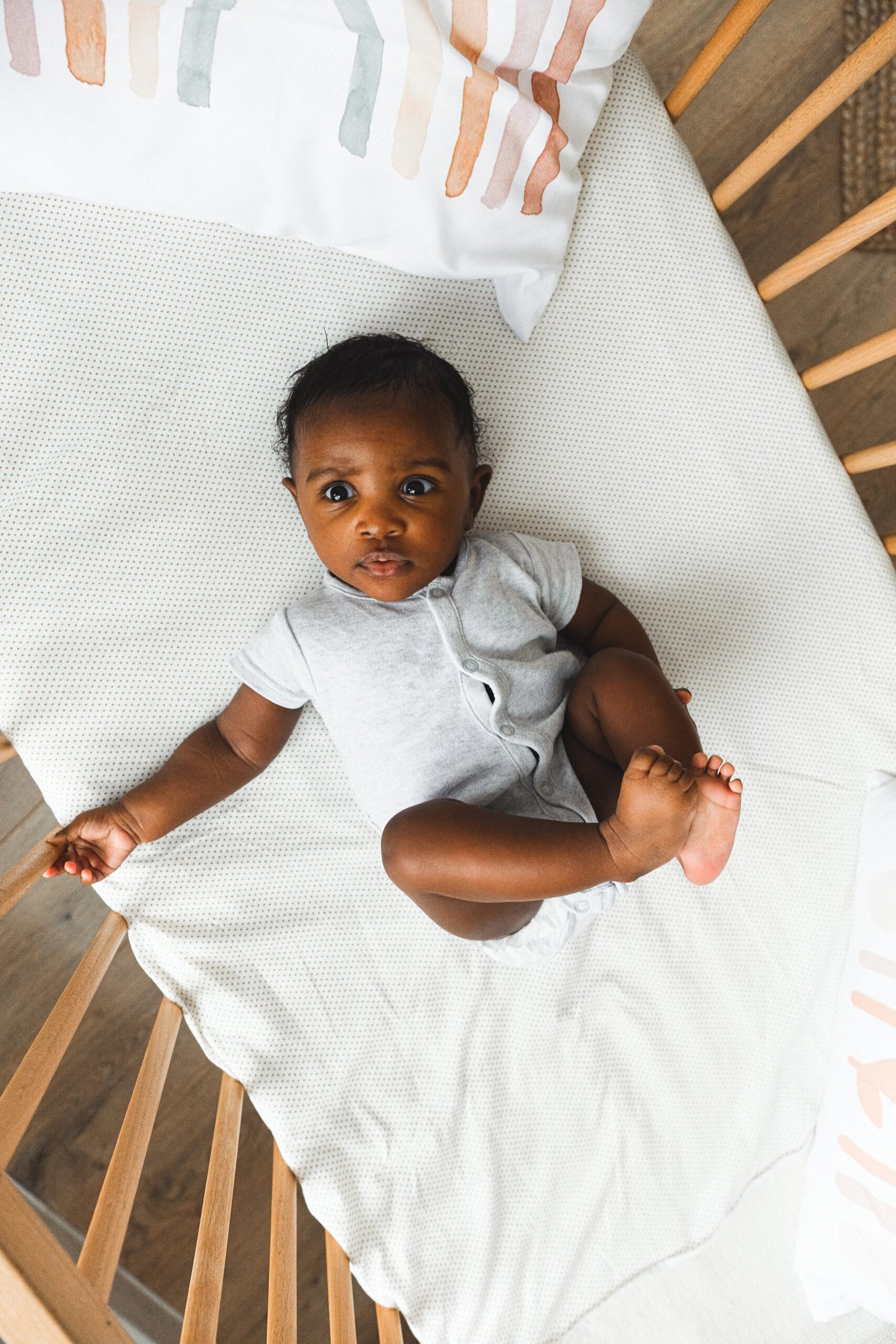I'm Rachael
Mom of 3 & Baby Sleep Expert with Big Sis Energy
& I’VE DONE ALL THE RESEARCH FOR YOU ALREADY.
Better sleep for the entire family
BROWSE COURSES
hey!
managing fear and anxiety at bedtime
February 24, 2024
in this post:
Between the ages of 2-3, many toddlers will experience a heightened level of fear and anxiety. This is partly because they go through a big developmental leap in their imagination, but their ability to distinguish between reality and fantasy doesn’t quite match up! Cue the sudden influx of questions about monsters…
Although many children will have some grip on the idea that something isn’t real, they still haven’t developed the skill set to be able to calm the anxious thoughts and rationalize the fear. At times like bedtime and overnight, this can feel particularly scary for them. For parents, this can seem daunting to navigate! You want to help your child and talk them through it but you don’t want to make the fear worse. These are my top tips for helping you through this period having been through it with my eldest two!
There are four elements in guiding your child through fears and anxieties: Reassurance, Investigation, Calming the Storm, and Finding Solutions.

1. Reassurance
Depending on when the fear arises there are more effective times to talk to your child and different ways to respond.
-
If the fear is immediate, such as in the middle of the night with a bad dream, then stay in the moment with them. Don’t ask for details- just stay lovingly present and state matter of factly that your child is safe there is nothing in the room or house that can hurt them, and that you are here to love them and look after them.
-
Your confidence and connection is the key to helping them move through the fear. Help them to feel snuggly and safe with cuddles, warmth, familiar songs, silliness, etc. Reassure them again that the house is safe, and the monsters aren’t real.
-
With nightmares it is important to help root your child back into their body. Offer a drink of water, slow your breathing down and theirs will naturally follow, play a game wiggling different body parts, offer a long hug, and offer your reassuring words.
‘I’m here. You’ve had a bad dream. The dream is not real. You are safe. I’m here. I love you.’
-
If the fear seems particularly large, lasts a long time, and isn’t calmed by your presence and proximity, and is affecting your child’s day to day life, then it might be a good idea to check in with a child therapist.
2. Investigate
Find a neutral time-not at bedtime, after the bad dream, or when your child is in a state of fight or flight- but a time when they seem calm and open to conversation.
-
Get curious – try to discover the root cause of the fear. Has it come from a show they are watching, a book they read, or conversations with friends?
-
Is it something in the room or house that’s acting as a catalyst for their imagination? Could it be a shadow, a creaky door, or a strange noise that’s causing their mind to run wild?
-
Role playing is a great way to talk through ideas. You can role play with your child or using stuffed animals/dolls. Make it silly and playful and see what direction you are led in.
-
Alternatively, you could draw the fear together and tell a story to discover what’s happening. Just ensure you make the activity feel safe and not pressured.
-
It’s important to note that in times of heightened stress such as significant life changes, children can experience an increased level of fear and anxiety which can lead to more bad dreams and night terrors. This may be after starting a new childcare or school, after the birth of a new sibling, after parents separation, etc.
3. Offering Calm
-
The fear is real to your child, make sure you are validating their experience and responding with empathy rather than shaming them or minimizing it. It might seem silly and irrational to you, but it is very real to them, and they are feeling afraid. If a child doesn’t feel heard or experiences shame and embarrassment when sharing their vulnerability, they will be put off from sharing again.
-
The key is to strike the right balance. You don’t want to exacerbate the problem or play into the fear, but you do want them to see that you know they are afraid and need love and support. Finding connection and empathy as well as safety and confidence is the balance you want to aim for.
‘Oh, that does sound like a scary thought. I used to be afraid sometimes when I was little too. I’m always here to keep you safe.’
4. Practical Tips and Solutions
There are often small tweaks that can be made to help reduce some of the fear and anxiety your little one is experiencing. One time it was as simple as figuring out a plant was making scary shadows on the wall and once we removed it the fear was alleviated.
-
If your infant is scared of the dark – offer a nightlight.
-
If their fear is being alone – let them know you will check in on them every few minutes, offer them a lovey, a photo of you, a t-shirt of yours. If they are scared of going somewhere in the house alone, toilet, upstairs, etc – offer to sing or leave your bedroom door open so they can still hear you and know you are still there.
-
If there is something making noises or shadows, brainstorm with them about how to overcome this. Once there was a plant making shadows on the wall in our son’s room that really freaked him out. Cover the monitor light, blackout curtains, a sound machine, etc. Our fridge was making noises and we made up a whole story about it being the fridge’s tummy grumbling. Find the playfulness to show your child they are safe.
-
If the fear is predominantly about bedtime and heightened by separation then focus on filling your child’s cup with connecting rituals at bedtime and remind them that you are close by and you can check on them as needed or lie with them if that works for your family.
-
If you would like help building a predictable, connection-oriented bedtime routine then my Better Bedtimes Guide is packed full of strategies and tips for building one and for navigating nighttime fears and anxieties.
Remember you are their anchor. Their calm, loving, safe space to help ground them when their imagination has run wild and they are feeling afraid! Inside the Better Bedtimes Guide, you learn exactly how to do this- setting loving limits while also being nurturing and compassionate to what your child is going through. You’ll learn:
-
How you can use routines, prep, play and connection with your child to set yourselves up for a calm and loving evening.
-
How to create the perfect evening routine for your family
-
Practical tools for bedtime battles you can start to implement right away.
-
Step by Step strategies for teaching your child to independently fall asleep
-
How to change the way your child goes to sleep (i.e. how to stop rocking or laying with your child)
-
How to support your child’s big emotions and what to do if there is crying
-
what to do during common scenarios like your child coming out of their room, taking an hour or more to fall asleep, visiting your bed in the middle of the night,
& SO much more! Click here to check out the course plus see some testimonials from parents just like you!
binge reads
We think you'll love these
You deserve to the
baby stage, not just "survive it."
And you DON'T have to sacrifice your values, ignore your instincts, or force yourself to follow a method you don't align with just to get your baby back to sleep.
I’m here to help you create a restful, sustainable sleep environment that honors both your baby’s needs AND your own (without the stress OR the guilt!) because, no, you don’t have to choose between the two.
enjoy!
BABY SLEEP COURSES →
BABY SLEEP CONSULTS →
Wish you could help your baby sleep better without resorting to sleep training? Download my FREE guide to a good night’s sleep and learn 8 simple, science-backed tips for supporting your child’s needs.
Traditional sleep training methods don’t have to be your solution to better sleep.
SLEEP TRAINING ISN’T THE ONLY WAY TO GET GOOD SLEEP
Hey, I'm Rachael and Hey, Sleepy Baby is for parents who want to get their nights back, without sleep training their babies.
NO ONE TOLD US POD
explorING the untold truths of parenting


